Comentarios / Preguntas (66)
Sachu escribió:
Hi, I have a question You say that when you reach 149 st, you can start the Lace pattern. Could i start the lace pattern at any point like at 113 st which is what i have now. Can i do that or does it have to be at 149 st? Thanks :)
29.10.2014 - 18:27DROPS Design respondió:
Dear Sachu, we have started the lace pattern with 149 sts in this pattern, but you may start earlier if you rather like to. Happy knitting!
30.10.2014 - 09:46
![]() Tone escribió:
Tone escribió:
Dette skjerfet er kjempefint! Svigermor har strikket dette i lysegrått baby alpakka silk, og det passer til alle aldre. Stilig med kombinasjonen vanlig rettstrikk og hullmønster.
13.10.2014 - 21:23
![]() Therese escribió:
Therese escribió:
Jeg forstår ikke hvordan jeg skal gjøre overgangen til hullmønster riktig? Man får,så vidt jeg kan skjønne, 149 m på 5. pinnen i "sjalmønsteret", og er da i "økeenden" av arbeidet. Når man da skal gå over til hullmønsteret, skal man starte på pinne 1 hullmønster, som er en "minskepinne". Da vil jo hele fasongen på sjalet endres? Kan dere forklare dette for meg?
06.09.2014 - 21:17DROPS Design respondió:
Hej Therese, Når du har 149 m strikker du de 4 pinde i HULLMØNSTER, udtagningerne vil da være på 3.p i samme side som du har taget ud hele tiden. Du vil snart kunne se formen på sjalet.
10.09.2014 - 12:21
![]() Marleen escribió:
Marleen escribió:
Gebreid op normale naalden maar het kantpatroon is recht aan beiden zijden. Dus hoe krijg ik de zelfde punt als aan de beginkant?
16.08.2014 - 16:53DROPS Design respondió:
Die krijgt u niet, het patroon is schuin en het patroon is niet gelijk op beide punten.
01.09.2014 - 16:49
![]() Odile escribió:
Odile escribió:
Fantastisch mooi patroon, maar ik vind breien op een rondbreinaald niet fijn. Kan deze sjaal ook op rechte naalden worden gebreid?
08.06.2014 - 17:22DROPS Design respondió:
Hoi Odile. Je moet aan denken dat je alle st kwijt kan op de rechte naald. Ik denk dat het best lastig kan worden met dit model, maar ik weet het helaas niet zeker. Het is uitproberen.
10.06.2014 - 16:19
![]() Lena Mörk escribió:
Lena Mörk escribió:
Återigen en fråga om hålvarven. Här finns nu två olika svar på frågor om detta. Ska det vara 149 m alla varv eller ska det ökas vart 4 e varv enligt det senaste svaret????
04.04.2014 - 21:43DROPS Design respondió:
Hej Lena. Når du har 149 M på pinden strikker du hälmønstret som også står i mønstret. Her tages der også ud, så følger du mønstret kommer det at gå fint :-)
07.04.2014 - 21:04Dana escribió:
Det ökas vart 4e v!
03.04.2014 - 18:27
![]() Karin escribió:
Karin escribió:
Bonjour, Merci pour les précisions. Par contre, je pense qu'il y a une erreur dans l'explication du rang 3 pour le point fantaisie. Il est mentionné : 1 m end, *2 m ens à l'end, 1 jeté*, répéter de *-* jusqu'à ce qu'il reste 4 m, 2 m end, 1 jeté, 1 m end, 1 jeté et 1 m end. En regardant la vidéo, on voit bien qu'il faut répéter de *-* non pas jusqu'à 4m mais jusqu'à 2m puis faire 1 jeté, 1 m end, 1 jeté et 1 m end.
02.04.2014 - 15:15DROPS Design respondió:
Bonjour Karin, les explications sont correctes, la vidéo sera bientôt modifiée pour être conforme au modèle. Merci. Bon tricot!
25.04.2014 - 11:31
![]() Anna Malm escribió:
Anna Malm escribió:
När jag börjat på hålmönstrat och ska börja på min andra runda så stämmer inte maskantal - kanten blir inte rak i sidan- dragit upp fyra ggr. Stämmer inte - vad gör jag fel ???
02.04.2014 - 06:18DROPS Design respondió:
Hej Anna. Kan det vaere du overser 1 omslag eller 2 räta tills? Hvis du har f.eks. 17 m paa st og strikker haalmönstrat, saa strikker du förste v saadan: 2 m räta tills (= 15 m kvar paa st) * 1 omslag, 2 m räta tills, * (= 7 gange gentages) og du der återstår nu 1 m = 1 omslag och 1 rm. Dvs, her er maskeantallet det samme. I varv 3 ökar du med et ekstra omslag.
08.04.2014 - 16:00
![]() LAURO escribió:
LAURO escribió:
Doit-on avoir jusqu'à la fin 149m car il m'arrive d'en avoir 150-151. Je fais peut-être une erreur. Merci pour votre réponse.
04.03.2014 - 12:19DROPS Design respondió:
Bonjour Mme Lauro, quand vous avez 149 m, répétez les rangs 1 et 4 du point ajouré, le nombre de mailles augmente à chaque rang 3, continuez ainsi pour former le triangle jusqu'à la hauteur indiquée/voulue. Bon tricot!
05.03.2014 - 09:38
Soir d'Été#soirdeteshawl |
|
 |
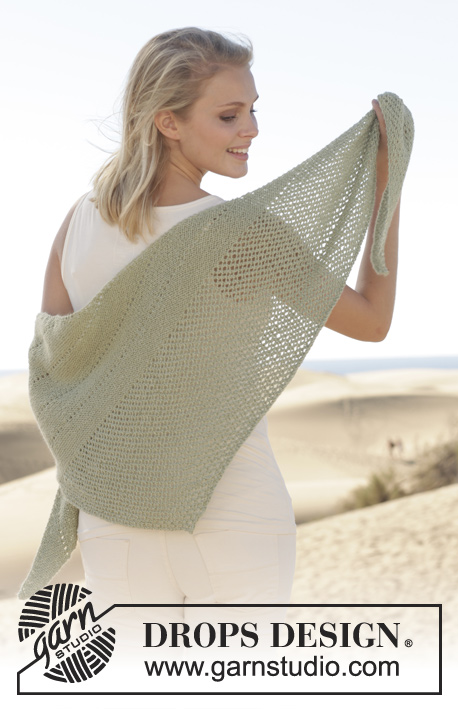 |
Chal DROPS tejido en punto musgo con patrón de calados, en “BabyAlpaca Silk”.
DROPS 152-16 |
|
|
PT MUSGO (de ida y vuelta en la ag): Tejer todas las hileras de derecho. 1 surco = 2 hileras tejidas de derecho. HILERA DE OJETES: Tejer una hilera de ojetes a cada 11º surco, la primera hilera de ojetes cuando haya 17 pts en la ag. La hilera de ojetes es tejida siempre en la 3ª hilera, es decir, la hilera que comienza con 2 pjd. Tejer la hilera de ojetes de la manera sig: 2 pjd, * 1 HEB (lazada), 2 pjd *, repetir de *a* hasta que reste 1 pt, 1 HEB y 1d. PATRÓN DE CALADOS: Hilera 1: 2 pjd, * 1 HEB, 2 pjd *, repetir de *a* hasta que reste 1 pt, 1 HEB y 1d. Hilera 2: Tejer todos los pts de derecho y las HEB. Hilera 3: 1d, * 2 pjd, 1 HEB *, repetir de *a* hasta que resten 4 pts, 2d, 1 HEB, 1d, 1 HEB y 1d. Hilera 4: Tejer todos los pts de derecho y las HEB. Repetir hileras 1 a 4. ------------------------------------------------------ CHAL: Tejido de ida y vuelta en ag circular. Mon 3 pts en ag circular tamaño 3.5 mm con BabyAlpaca Silk y tejer 1 hilera de derecho. Después tejer en PT MUSGO – ver explicación arriba, de la manera sig: HILERA 1: 1d, 1 HEB, 1d, 1 HEB y 1d = 5 pts. HILERA 2: Tejer todos los pts de derecho. HILERA 3: 2 pjd (flojamente), tejer de derecho hasta que reste 1 pt, 1 HEB y 1d. Esta hilera es sustituida con la hilera de ojetes a cada 11º surco. HILERA 4: Tejer todos los pts de derecho. HILERA 5: Tejer hasta que resten 2 pts, 1 HEB, 1d, 1 HEB y 1d. Después repetir las hileras 2 a la 5 hasta que haya 17 pts en la ag. **Continuar como antes, pero sustituir la 3ª hilera con la HILERA DE OJETES – ver explicación arriba. Después tejer como antes en pt musgo y con los aum/dism como antes, sin la hilera de ojetes, hasta haber aum 12 nuevos pts ** = 29 pts en la ag. Repetir de **a** hasta haber tejido 11 hileras de ojetes (12 nuevos pts aum). Tejer la hilera de ojetes cuando haya: 17, 29, 41, 53, 65, 77, 89, 101, 113, 125 y 137 pts en la ag. Continuar en pt musgo con los aum/dism como antes hasta que haya 149 pts en la ag, después tejer el PATRÓN DE CALADOS – ver explicación arriba. Repetir las hileras 1 a la 4 del patrón de calados hasta que la pieza mida aprox 106 cm medida a lo largo de la aguja/lado corto. Terminar después de la 2ª o 4ª hilera en el patrón de calados y rem flojamente con pts derechos. Cortar y rem el hilo. |
|
¿Terminaste este patrón?Entonces, etiqueta tus fotos con #dropspattern #soirdeteshawl o envíalas a la galería #dropsfan. ¿Necesitas ayuda con este patrón?Encontrarás 10 videos tutoriales, un espacio para comentarios/preguntas y más visitando la página del patrón en garnstudio.com © 1982-2025 DROPS Design A/S. Todos los derechos reservados. Este documento, incluyendo todas sus sub-secciones, está protegido por los derechos de autor (copyright). Lee más acerca de lo que puedes hacer con nuestros patrones en la parte de abajo de cada patrón de nuestro sitio. |
|














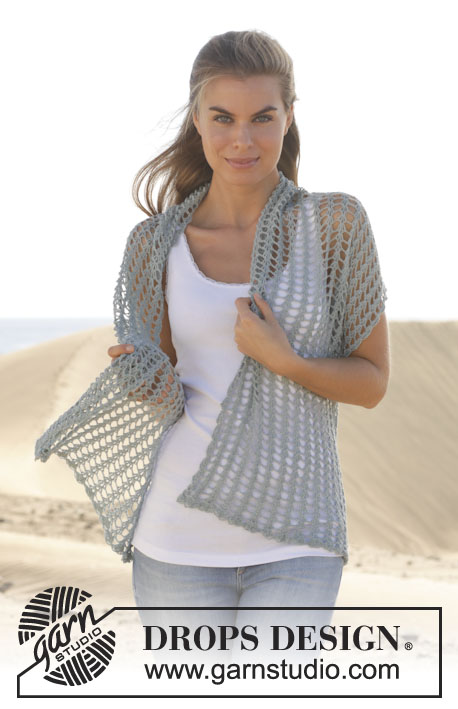
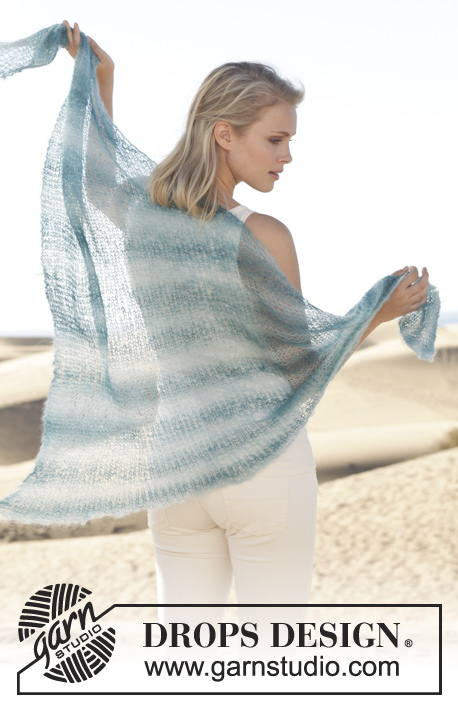






















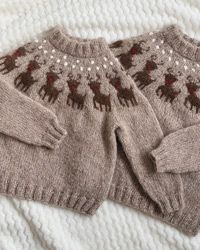

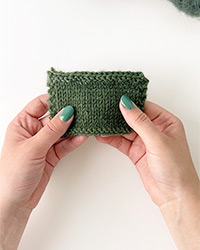

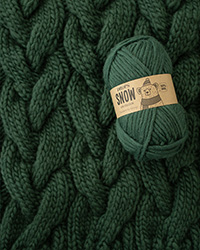
Escribe un comentario sobre DROPS 152-16
¡Nos encantaría saber qué piensas acerca de este patrón!
Si quieres escribir una pregunta referente al patrón, por favor asegúrate de elegir la categoría correcta en el formulario debajo, para acelerar el proceso de respuesta. Los campos obligatorios están marcados con un *.